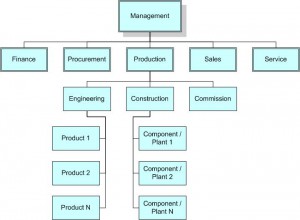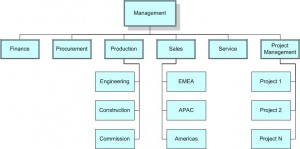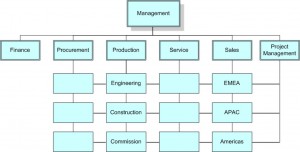My last article dealt with the way how to turn a distressed project to success or at least receive a useful benefit from it. It ended with an appeal towards the managers responsible for projects and company not to stop at this point but to use the insights received from the mistakes made to reasonably terminate the ultimate causes for repetitive issues in projects, to achieve a sustainable turnaround.
Theses causes are sufficiently known latest after my many previous articles (see https://eobz.de/category/tips-discussions/), but also looking at the uncounted studies on this subject. In most cases the sources can be found in the company’s acknowledgement of projects in general and of good project management in particular.
Companies with project-driven business model are impacted most
At this business model the dominant business happens in projects, e.g. in customer projects. But also enterprises whose business is vastly influenced by changes that imply a high number or frequency of investments and adaptations in their business are project-driven.
 In Europe enterprises typically have an established line organization structure with functional and central departments. This is especially the case in our traditionally strong industries like Mechanical and Plant Engineering and in particular in privately owned, mid-size companies, but also at consulting and IT firms, engineering and development bureaus etc. Often I find a distinctive own life of the departments, production locations or plants with silo thinking, insufficient communication and cooperation. This becomes very evident with cross-functional work in projects.
In Europe enterprises typically have an established line organization structure with functional and central departments. This is especially the case in our traditionally strong industries like Mechanical and Plant Engineering and in particular in privately owned, mid-size companies, but also at consulting and IT firms, engineering and development bureaus etc. Often I find a distinctive own life of the departments, production locations or plants with silo thinking, insufficient communication and cooperation. This becomes very evident with cross-functional work in projects.
A pity if the company actually depends on profitably delivering projects i.e. seamless overall collaboration, and actually not on prospering of single organizational units. In most cases of companies with a traditional set-up but project-driven business this discrepancy can be detected also in the books with revenue, profit and market share decreases. That is because for them the market has changed dramatically in the recent years. These companies urgently need a turnaround not only in single distressed projects but for the entire organization.
Rebuilding the culture must be the first step
Nothing is harder to change than established, beloved habits. Many entrepreneurs and executives already have failed to break up traditional structures and delineated thinking, to “turn” department princes, and to have their enterprise undergo a drastic treatment to achieve the turnaround. To succeed the company culture concerning its projects first needs to change authentically. And this starts at the very top at the executive management.
An intensive Change Management process commences which can’t happen overnight. This is what counts:
- Understand where the money comes from. That is no more just having a good product. It also needs to be delivered reliably, assembled and commissioned, at a fair price as contracted. The business actually is no longer product- but project-driven. And by the way the company needs to earn good money (after all). Ergo
- Comprehensive instead of local optimization. This means that the profit doesn’t derive from the single production lines and functional departments but in the projects which deliver the whole completely as a package. Efficient collaboration across department borders makes nice company margins, not good single functions’ results alone. It also takes to consequently
- Incorporate prestages and suppliers. They also need to be driven by the projects, at least when collaborating with them. Because if they don’t contribute to plan even the own, compelling project planning becomes maculation. Therefore you need to accurately investigate who fits in concerning his performance and organizational maturity, re-negotiate contracts with the new criteria, sharpen and align control mechanisms, expediting and claim management accordingly.
Only if all involved have understood what project-driven business is about, and only if the management backs it up authentically, the turnaround will succeed. And only then you will succeed to implement the reshaping now following without costly resistance.
Rebuilding the organization is logical consequence and fundament
If you focus on your projects’ commercial success your corporate organization needs to fit and reflect this. A profitable, project-driven firm needs to have a good and professional project management. Ergo your company in the future needs a strong
 Project management as a core competency and strong department. Quit with functional specialists who lead the projects at the side. Project management needs full attention on planning, coordination and leadership – actually same as with corporate management. Time and objective conflicts of two hearts in the project leader’s chest are poison for concentrating on the essentials. His “thinking” also needs to be project-driven, no longer product love struck. Everybody contributes his core competence, the engineer his functional knowledge, and the project manager his PM skills, for success of the total. Process models and best practices make it replicable and calculable.
Project management as a core competency and strong department. Quit with functional specialists who lead the projects at the side. Project management needs full attention on planning, coordination and leadership – actually same as with corporate management. Time and objective conflicts of two hearts in the project leader’s chest are poison for concentrating on the essentials. His “thinking” also needs to be project-driven, no longer product love struck. Everybody contributes his core competence, the engineer his functional knowledge, and the project manager his PM skills, for success of the total. Process models and best practices make it replicable and calculable.
Flanking focused resource assignement and legwork
Unfortunately companies mostly have too few of both subject matter experts for all of the important projects at hand. This is why they need a structured and economically effective
- Portfolio management, to prioritize their projects objectively and assign their resources for an optimum of business benefit. It’s not gut feeling and preferences, and not at all who shouts the loudest that determines which projects are important for the company. You need to consider that there still will be critical internal projects which are only linked indirectly with the revenue even with a project-driven business model. Criteria for all projects need to be corporate objectives, strategy, risk, profit, balance of initiatives and load capacity of the organization. The means are cost-utility analysis, (may be) Balanced Scorecard and tangible KPIs. Controlling must be consequently according to facts and to time. That is how the discussions und decisions get transparent and safe.
So far with the „new brooms“, but to succeed with the transition for the turnaround you still need a re-shaping at the layout and self-image of
 Functional and central departments as service providers for the projects. The previously gone through change in your corporate project culture will help you here. The engineers’ provisions will now not only serve for the product’s perfection but also for the whole task’s delivery to contract. Procurement will not only look at the terms and conditions but also (may be even sometimes with concessions supporting the project targets) at the reliability of delivery. Legal will probe partnership in collaboration; QM controls the project’s product quality and drives process quality (Continuous Improvement). HR will search for skills instead of positions, train for future project requirements, take care for a corporate identity among the employees, etc.
Functional and central departments as service providers for the projects. The previously gone through change in your corporate project culture will help you here. The engineers’ provisions will now not only serve for the product’s perfection but also for the whole task’s delivery to contract. Procurement will not only look at the terms and conditions but also (may be even sometimes with concessions supporting the project targets) at the reliability of delivery. Legal will probe partnership in collaboration; QM controls the project’s product quality and drives process quality (Continuous Improvement). HR will search for skills instead of positions, train for future project requirements, take care for a corporate identity among the employees, etc.
This is no „clean sweep” but indeed an extensive re-shaping of the corporate organization, not only in its structure, because accompanying you need to
Also relaunch incentive systems
All structure and mind-set changes will fall back into old patterns and the turnaround will get stuck if the colleagues will go on to be rewarded for the old instead of the new behaviours i.e. not project-driven as well. Department managers must no longer be measured by their departments’ success and size only, colleague no longer primarily by product quantity or quality. What’s essential is the contribution to the complete picture, the performance in the projects, teaming, reliability, taking responsibility, process improvement, personal growth and skills enhancement, usability and flexibility. These are the success factors for the turnaround and the company’s fitness for the future.
For example Sales will no longer be provisioned for a maximum of sold projects but for good ones with good margins and realistic agreements on delivery. Procurement’s target will no longer be highest discounts possible but favourable conditions which allow suppliers realistic approaches and calculations and still are attractive for prioritized, reliable deliverables. A success measurement could be e.g. provisions on time or low failure.
At HR this is analogous properly staffed projects or less resource bottlenecks at good utilization same time. QM receives bonus for process improvements that further increase efficiency and effectiveness of communication, process flow and cooperation. You probably have plenty more good examples now, do you? In any case the basis for incentives for sure will be a close collaboration and coordination with each other and with the project and portfolio management, because this is also the basis for the turnaround.
Your reward
When your company finally has managed the turnaround and is completely wired project-driven you will not need to fear any benchmark in your industry. You will regain eventually already lost market shares and even more. Most of all you will come back to enjoy your margins and profits, not to talk about the joint success that all colleagues will feel and appreciate. Success makes sexy – that also applies to enterprises !
I hope I could give you some helpful suggestions with these lines. Believe me: these thoughts can be continued infinitely. I find a lot of pleasure in it, and, if you like to, also together with you in your very individual turnaround.
